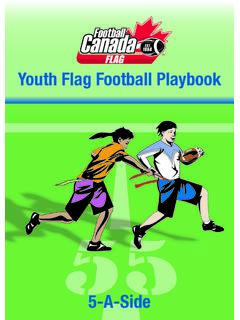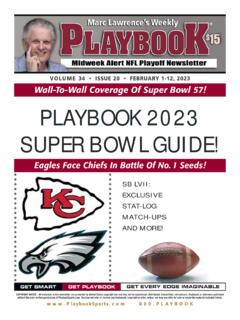Transcription of THE WING-T FOR YOUTH
1 THE WING-T FOR YOUTHA Playbookby Ted SeayCopyright 2007 by Edmond E. Seay III- 2 - 2 TABLE OF CONTENTSI ntroductionPage 3 The WING-T SystemPage 5{20 Series - Jet SweepORPage 820 Series - Rocket Sweep}Page 1680 Series - Belly/DownPage 2410 Series - Sprint PassingPage 31 Attacking with the YOUTH wing -TPage 38 There is no last move in strategic and military competition. - Professor Colin S. Gray- 3 - 3 INTRODUCTION: Adapting the WING-T to YOUTH FootballI have written this brief playbook in answer to a number of requests for a good, sound system of WING-T football for YOUTH players. I have tried to make this offense a true sub-system of the classic Delaware WING-T offense as it has been adapted over the years, using formation terminology and play numbering consistent with those used by most WING-T coaches who have followed the Delaware have also, however, made use of two of the most important offensive innovations of the last several decades -- the Jet Sweep series and the Rocket Sweep series.
2 Older teams may decide to run both series as part of an expanded WING-T attack, but I strongly recommend that YOUTH coaches who are looking at this playbook do so with the intention of using EITHER the Jet OR the Rocket as their speed sweep series. For this reason, I have numbered both the Jet and the Rocket series in this playbook as the 20 series. Again, for YOUTH coaches this should be an either/or rest of the offense includes the classic Delaware 80 series, in this case including both the Belly and the Down sequences of plays, allowing coaches to attack off-tackle either to the TE/WB side or the Slot/SE side of the formation. In both cases, I have added recent innovations in the form of the Belly Sweep and Down Sweep as used by Washington s Bellevue High School and other leading practitioners of the modern WING-T . These plays allow you to get outside when defenses squeeze down on the C gap from outside, just as the complements to the Jet and Rocket sweeps allow you to attack inside when the defense tries to stop the speed , the passing game is a simple one, but can be expanded as desired.
3 I urge coaches to install and perfect the plays which appear here before they start broadening the playbook too much, however. The plays listed in the 10 (Sprint) series will go a long way toward defeating opponents without adding anything else, and focusing your passing game and pass-action runs (13 Down Special, p. 33; 16 Belly, p. 34; and 18 Down, p. 36) on so few plays will allow you to perfect the other aspects of your all, I recommend these 13-15 plays to you as a complete, powerful YOUTH offense. Again, teach them well and you will go much further than teams which try to install 50-60 plays without mastering any of them. The premise behind the WING-T is that series-based football keeps the defense guessing for that crucial half-second after the snap as to the eventual location of the football. If you teach perfect execution of these plays, the offense and its decades of refinement will take care of the 4 - 4 THE WING-T SYSTEMRED FORMATIONA lthough the modern WING-T system is a multi-formation complex, I strongly recommend that YOUTH coaches stick with one formation, known universally as Red (when the TE and WB are aligned to the Right) and Blue (when the TE and WB align Left).
4 This will allow your players to adapt to and learn the system much more quickly, without causing you any additional problems such as giving away useful keys to the also recommend that coaches above the 7-8 year old level install both Red and Blue formation, and that they do so by flipping all personnel except the Center, QB and Fullback to the other side of the formation. This way players stay in the same relative alignment to each other, and, more importantly, cut their play learning task in half. It is much, much easier for the 3 Tackle (who always lines up inside the TE) to learn how to block the same play to his right in Blue formation and to his left in Red formation than it is for him to always remain the Right Tackle and have to learn different assignments for blocking the same play from Red and from Blue formation. If you use both Red and Blue, flip-flop your personnel.
5 (Note: I have diagramed all plays in Red formation for the benefit of those coaching the bobbleheads. )BLUE FORMATION- 5 - 5 Since there is only one formation in use, coaches can omit the first digit in the classic Delaware WING-T numbering system, which stands for the formation. This means you can either call Red or Blue in the huddle, followed by a two-digit play number, or else you can just decide that you will set either the TE or the SE to the width of the field, and just call the two-digit play number. This latter system is especially useful if you are using a no-huddle are numbered by series in the WING-T , and the plays in this book follow suit:10 (Sprint) Series:Page11 Flood 3112 Fade 3213 Down Special 3316 Belly 3417 Go 3518 Down 3619 Stick 37{20 (Jet Sweep) Series:21/29 Jet Sweep 824/26 Jet Dive 1028 Jet Waggle 1223/27 Jet Slam 1322 Jet Reverse 1520 (Rocket Sweep) Series:21/29 Rocket Sweep 1622/28 Rocket Belly Sweep 1823/27 Rocket Belly 2024 Tackle Trap 2225 Waggle 23}80 (Belly/Down) Series:80 Down Pass 3081 Down Sweep 2982 Down 2884 Tackle Trap 2787 Belly 2488 Belly Keep 2689 Belly Sweep 25 YOUTH teams that choose either the Jet Sweep or the Rocket Sweep as their 20 series will therefore run a total of about 14 plays.
6 Older teams that choose to use both will have as much as a 20-play repertoire, and of course can also choose to expand the passing game ( , both the 10 series and play-action passes for each of the three run-based series).- 6 - 6 PERSONNEL REQUIREMENTSS plit End: This is ideally not a position for Smurfs -- the split end should have a bit of size and blocking ability, as well as the kind of football quickness that will help him gain separation from man defenders. He will normally split from the OT by about 10-12 yards (although we can line him up as close as 1 yard outside the OT, and can even replace him in that position with a second TE).Tight End: A prototypical tight end, big, strong and a good blocker with hands. Not too many deep pass routes for him, but plenty of angle blocks on linemen and backers in the defensive : Speed kills. This should be the fastest man on your team who can catch a football.
7 I believe fast people can be taught how to run the speedsweep well, but you can't teach good runners speed. Like the SE, the WB must be able to block downfield, although he is called on more often to drive a defender deep, then screen him off from the ball once he reacts up to the : The key to your running game. Once defenses unbalance themselves to shut down the speed sweeps, you have to be able to hurt them with divesand traps up the middle and off-tackle to the FB. He is also the heart and soul of the 80 series, so choose carefully. Smaller and quicker can work as well as bigger and stronger, but you want that great forward lean when running with the ball, as well as someone who smells the goal line when you get down close to the end : A good, tough runner with a bit of speed fills the bill very nicely. Good hands are a big advantage as : Lots of faking and ball-handling, and some passing.
8 If you have a good runner who is also your best passer, you can play him here -- but if your best and fastest runner can pass a bit, put him in at wingback and install an option pass for (3 and 7): Rarely asked to block more than one gap over (down blocks and cut-offs), limited pulling or trapping (24/84 Tackle Trap). Should be your biggest, strongest (4 and 6): Your premier pullers and trappers. Should be big and strong enough to serve in the middle of the wedge with the Center. They should also master down and cut-off : Must be steady, willing to work hard to master the art of snapping and then blocking either gap or straight 7 - 7 Line Splits: I recommend one-foot line splits all the way across. The TE can split 2 to 3 feet, depending on his ability to block his inside gap -- the slower he is, the tighter he will have to align to the 3 Wingback lines up a yard outside and a yard behind the TE.
9 The Slotback lines up a yard outside and behind the 7 Tackle. The Fullback s heels are 4yards deep, directly behind the Quarterback. You can line him up in either a two-point or a three-point 8 - 8 THE RUNNING GAME: 20 (Jet Sweep) Series*21 Jet Sweep7 Tackle: Run your track playside; if someone crosses your face hard, block him in that direction all the way to the sideline. Otherwise, reach first bad color in second or third Guard: Run your : Run your Guard: Run your Tackle: Run your : Reach the end man on the LOS (EMLOS).SE: Drive your Corner : Drive deep for the Corner and reach him if possible -- if not, push him to the : Fly motion to near B gap, take hand off and slide step a yard farther away from the LOS. Then run to hashes, numbers, & : Fake 24 Jet Dive. Tell coach when defenders stop tackling : Reverse pivot, hand to SB, fake to FB, then boot away from sweep.
10 Read EMLOS on Boot side to see if he is following you. Tell coach when he stops following you. * For younger teams, the essential plays in the Jet Sweep series are: All of 9 - 929 Jet Sweep7 Tackle: Run your track playside; if someone crosses your face hard, block him in that direction all the way to the sideline. Otherwise, reach first bad color in second or third Guard: Run your : Run your Guard: Run your Tackle: Run your : Pizza block for ballcarrier downfield when he cuts back - if you pancake your man and the runner scores, the coaches buy pizza for the whole offense!SE: Stalk your : Fly motion to near B gap, take hand off and slide step a yard farther away from the LOS. Then run to hashes, numbers, & : Reach the end man on the LOS (EMLOS).FB: Fake 26 Jet Dive. Tell coach when defenders stop tackling : Reverse pivot, hand to WB, fake to FB, then drop back to fake 10 - 1024 Jet Dive7 Tackle: Run your track playside; if someone crosses your face hard, block him in that direction all the way to the sideline.






